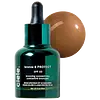Typology T34 - Bronzing Drops Vitamin E 2% Versus ciele. Bronze & Protect SPF 50 Bronzing Concentrate SPF 50+
What's inside
What's inside
 Key Ingredients
Key Ingredients

 Benefits
Benefits

 Concerns
Concerns

 Ingredients Side-by-side
Ingredients Side-by-side

Water
Skin ConditioningC13-15 Alkane
SolventHeptyl Undecylenate
EmollientMica
Cosmetic ColorantGlycerin
HumectantPropanediol
SolventTocopheryl Acetate
AntioxidantSynthetic Fluorphlogopite
Pentylene Glycol
Skin ConditioningBenzyl Alcohol
PerfumingPrunus Armeniaca Kernel Oil
MaskingSphingomonas Ferment Extract
Skin ConditioningSucrose Distearate
EmollientSucrose Stearate
EmollientDehydroacetic Acid
PreservativeSodium Phytate
CI 77491
Cosmetic ColorantCI 77891
Cosmetic ColorantCI 77499
Cosmetic ColorantWater, C13-15 Alkane, Heptyl Undecylenate, Mica, Glycerin, Propanediol, Tocopheryl Acetate, Synthetic Fluorphlogopite, Pentylene Glycol, Benzyl Alcohol, Prunus Armeniaca Kernel Oil, Sphingomonas Ferment Extract, Sucrose Distearate, Sucrose Stearate, Dehydroacetic Acid, Sodium Phytate, CI 77491, CI 77891, CI 77499
Zinc Oxide 12%
Cosmetic ColorantWater
Skin ConditioningC12-15 Alkyl Benzoate
AntimicrobialButyloctyl Salicylate
Skin ConditioningLauryl PEG-8 Dimethicone
Isododecane
EmollientPropanediol
SolventIron Oxides
CI 77491
Cosmetic ColorantSynthetic Fluorphlogopite
Dimethicone
EmollientNiacinamide
SmoothingPolymethylsilsesquioxane
Isohexadecane
EmollientTrilaureth-4 Phosphate
EmulsifyingDimethiconol
EmollientMica
Cosmetic ColorantCaprylyl Methicone
Skin ConditioningOctyldodecyl Neopentanoate
EmollientLauryl PEG-10 Tris(Trimethylsiloxy)Silylethyl Dimethicone
EmulsifyingCI 77492
Cosmetic ColorantSodium Chloride
MaskingPhenoxyethanol
PreservativeBisabolol
MaskingDisteardimonium Hectorite
StabilisingCI 77499
Cosmetic ColorantCaprylyl Glycol
EmollientAllantoin
Skin ConditioningTitanium Dioxide
Cosmetic ColorantEthylhexylglycerin
Skin ConditioningHexylene Glycol
EmulsifyingPropylene Carbonate
SolventPolyglyceryl-4 Diisostearate/Polyhydroxystearate/Sebacate
EmulsifyingPEG-10
HumectantTetrasodium Glutamate Diacetate
Hydrogenated Lecithin
EmulsifyingTin Oxide
AbrasiveSodium Hydroxide
BufferingZinc Oxide 12%, Water, C12-15 Alkyl Benzoate, Butyloctyl Salicylate, Lauryl PEG-8 Dimethicone, Isododecane, Propanediol, Iron Oxides, CI 77491, Synthetic Fluorphlogopite, Dimethicone, Niacinamide, Polymethylsilsesquioxane, Isohexadecane, Trilaureth-4 Phosphate, Dimethiconol, Mica, Caprylyl Methicone, Octyldodecyl Neopentanoate, Lauryl PEG-10 Tris(Trimethylsiloxy)Silylethyl Dimethicone, CI 77492, Sodium Chloride, Phenoxyethanol, Bisabolol, Disteardimonium Hectorite, CI 77499, Caprylyl Glycol, Allantoin, Titanium Dioxide, Ethylhexylglycerin, Hexylene Glycol, Propylene Carbonate, Polyglyceryl-4 Diisostearate/Polyhydroxystearate/Sebacate, PEG-10, Tetrasodium Glutamate Diacetate, Hydrogenated Lecithin, Tin Oxide, Sodium Hydroxide
Ingredients Explained
These ingredients are found in both products.
Ingredients higher up in an ingredient list are typically present in a larger amount.
Ci 77491 is also hydrated iron III oxide. It's sole purpose is to give a red/pink hue to products.
Iron III oxides are classified as inorganic chemicals for coloring.
Synthetically created Ci 77491 is considered safer than those naturally found. This is because the synthetically created version may contain less impurities. Iron oxides are generally non-toxic and non-allergenic.
Learn more about CI 77491Ci 77499 is also hydrated iron III oxide. It is created from mixing red and black iron oxides. This helps give shades of darkness to a product.
Iron III oxides are classified as inorganic chemicals for coloring.
Mica is a naturally occurring mineral used to add shimmer and color in cosmetics. It can also help improve the texture of a product or give it an opaque, white/silver color.
Serecite is the name for very fine but ragged grains of mica.
This ingredient is often coated with metal oxides like titanium dioxide. Trace amounts of heavy metals may be found in mica, but these metals are not harmful in our personal products.
Mica has been used since prehistoric times throughout the world. Ancient Egyptian, Indian, Greek, Roman, Aztec, and Chinese civilizations have used mica.
Learn more about MicaPropanediol is an all-star ingredient. It softens, hydrates, and smooths the skin.
It’s often used to:
Propanediol is not likely to cause sensitivity and considered safe to use. It is derived from corn or petroleum with a clear color and no scent.
Learn more about PropanediolSynthetic Fluorphlogopite is the synthethic version of mica. It consists of fluorine, aluminum and silicate.
Synthetic Fluorphlogopite is used to add volume to products.
It is considered non-irritating on the skin.
Learn more about Synthetic FluorphlogopiteWater. It's the most common cosmetic ingredient of all. You'll usually see it at the top of ingredient lists, meaning that it makes up the largest part of the product.
So why is it so popular? Water most often acts as a solvent - this means that it helps dissolve other ingredients into the formulation.
You'll also recognize water as that liquid we all need to stay alive. If you see this, drink a glass of water. Stay hydrated!
Learn more about Water